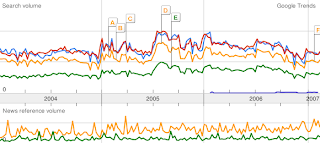One very popular instance of serendipitous research occurred when Pfizer was working on an angina medicine and discovered the profound effects of Viagra. Here is another, less popular instance…The Anti-Hoarding Drug!
Patient Conversation of the Week
Excerpts from especially memorable patient encounters:
ME: So what made your back pain worse?
Patient: The Physical Therapy made is worse.
ME: Well, what did you do in PT?
Patient: What they told me to do.
ME: What did they tell you to do?
Patient: Things that hurt.
Excellent!
Labels: physical therapy
Here Comes Google!
Labels: health policy, health tools, Science Literacy
Why Do They Smoke?
Labels: current press, misc.
Drug Companies Eat Zebras?
Those of you who regularly read my blog and know me at all, are probably very aware of my distaste for pharmaceutical companies and their perpetual courtship of physicians.
Here is an article that has some solid numbers behind it, including a couple instances of doctors receiving money from a drug company AND making guidelines for other doctors to follow that includes the drug they are being paid to promote!
Did you hear that? A doctor may make guidelines for how much and often a kidney patient receives a cholesterol medication even while being paid by the manufacturer of that medication. Outrageous!
How, in light of this conflict of interest, are we to trust any formal guidelines at all?
Does anyone else see a problem with this? This guy from Harvard does:
Labels: health policy, physical therapy, Science Literacy
The Evolution of Rehabilitation
A series of blog posts led me to MedInnovationBlog, where I read a post: On Physical Therapists and Keeping Patients Moving.
That was nice to see and read about. Then came the comments. Physiatrists, upset that one could write about the profession of Physical Therapy and not give them credit. The blog author seemed pathetically apologetic in his response, and even went so far as to quickly credit Physiatrists for helping train Physical Therapists. Some clarification is needed.
The history of both Physiatry and Physical Therapy have very closely knit roots. In reviewing several sources of historical information on these professions, I find it interesting that neither mentions the other. Odd, because careful reading of these histories suggest each profession arose out of the same need and then developed independently.
Both professions start out with claiming roots to Hippocrates and the such….but let’s start at a more realistic date: World War I and 1917.
The Army, trying to deal with many injured soldiers, commissioned two physicians to create the Division of Physical Reconstruction upon recommendation from the Division of Orthopedic Surgery. The two physicians, Frank Granger, MD, and Joel Goldthwait, MD, signed on two Reconstruction Aides (read: Physical Therapists) who had already been trained and were helping patients with polio in Europe and the U.S. with rehabilitative modalities. They were Marguerite Sanderson and Mary McMillan. All four of these individuals eventually became influential in the founding and growth of the two professions in question. Each profession initially faced a struggle to become an accepted part of the current medical establishment.
Today, the two professions are largely separate, with unique educational programs and autonomy. The growing knowledge base of one is interdependent upon the other and each must yield respect accordingly. In my daily routine, I use the professional journals of each equally.
There is, however, one significant change upon us. For the first time, Physical Therapists are not dependent upon physicians for prescriptions, diagnoses, or treatment plans and are being educated to the doctorate level. It will be interesting to see how the relationship between these two mutually beneficial professions will continue to evolve in light of these changes.
Labels: physical therapy
Google Searching for Back Pain
Labels: back pain, health tools, physical therapy
Calculator Day
 A pound of body fat (see image) equates to approximately 3500 calories. So a calorie deficit of 500 calories (meaning that you burn 500 calories more than you eat each day) you would lose approximately one pound per week:
A pound of body fat (see image) equates to approximately 3500 calories. So a calorie deficit of 500 calories (meaning that you burn 500 calories more than you eat each day) you would lose approximately one pound per week:
Labels: health tools, misc., physical therapy
Pay For Performance, An Overview
For those of my readers who work in the medical field, perhaps the title of this post caused a slight shudder or tingling in the spine. Understandable, indeed, as we have become accustomed to health insurers devising ways to reduce payments under the guise of improved quality of care. But, as a provider interested in improving my performance and having “Quality” be a marketable part of my services, I can see potential value in the concept.
For those who have never heard of Pay 4 Performance, an quick overview is indicated:
Insurance companies, Medicare included, are developing systems of payment for medical services based on performance, or quality. For example, a Physical Therapist that reports the risk of falls for each patient would be eligible for improved reimbursement. A physician who screens for cervical cancer would benefit likewise.
A good overview is available via this article, last week in The LA Times. It talks about a state-wide pilot program in California. California is the state where managed care and HMO’s came from too.
While improving healthcare quality is a vitally important part of reform, healthcare providers are nervous that these initiatives will become mandated before the details are worked out.
Details like:
- Currently, there is no agreed upon measures of what “Quality” practice consists of.
- Physical Therapists worry about measures having anything to do with PT at all, instead just being a poorly translated medical-based measure.
- How will the system compensate for those times when quality measures don’t make sense i.e. measuring for fall risk in a bed-bound or wheelchair bound patient.
- The list of concerns goes on.
In short, this change is coming, but everyone in concerned that it might just be more hoops to jump through to get paid, and that healthcare quality will not improve because of it. Careful planning is needed if quality is to improve. Either way, the insurance companies are gaining a tool to withhold more payments, and presumably, increase their bottom line. Personally, I hope it works out…maybe we could weed some of the detractors of quality out of our profession.
Here are some links:
Board of Directors of IHA, a leading institution behind this measure (note insurance bias of board)
Labels: health policy, physical therapy, Science Literacy
The Galapagos Islands and Huntington's chorea
Ahh, Blue-Footed Boobies!
One of my favorite authors, Kurt Vonnegut, wrote about Huntington’s Disease in the great book, Galapagos. The main character’s pending and inevitable onset of neurological wasting intrigued me. I tried to imagine what that must be like.
Since Mr. Vonnegut wrote that book, researchers have identified the gene in question that causes this disorder, and tests are now available for only a couple hundred dollars for people who are at risk. Today’s New York Times, had an excellent piece on Huntington’s Disease, Facing Life With a Lethal Gene.
I no longer have to imagine what it must be like to have it. The article really lays it out with the story of Ms. Moser, a young Occupational Therapist who carries the gene.
To circle this wagon back around, tonight, the National Geographic Channel is having a special called, Galapagos, “It’s like no where else.”
So what am I really talking about here? Evolution. It’s everywhere!
Labels: current press, evolution





